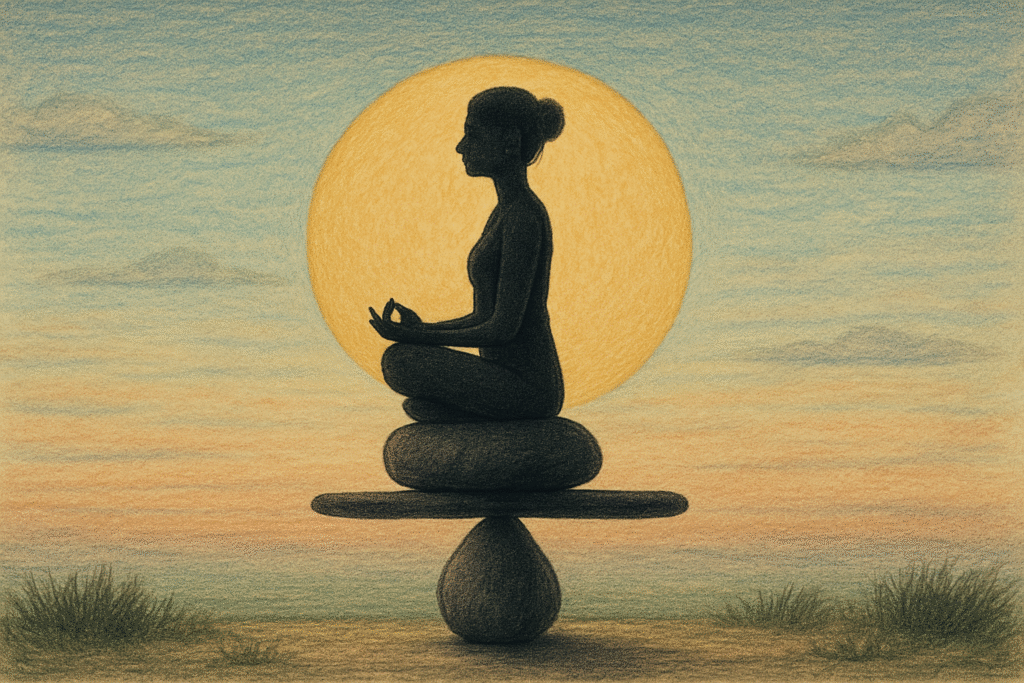In every breath lies a secret — a rhythm that connects life and consciousness. The simple act of inhaling and exhaling is not just a biological function; it is a profound metaphor for balance, presence, and harmony.
At Nada Yoga School in Rishikesh, we teach our students that yoga is not only about movement but about living between these two breaths — in the sacred pause where stillness meets awareness.
Understanding the Space Between the Breaths
In yogic philosophy, prāṇa — the vital life force — flows through every inhale and exhale. But it is the kumbhaka, the moment of stillness between them, that holds the key to balance.
Types of Breath in Yoga Practice
- Pūraka (Inhalation): The act of drawing in energy, life, and inspiration.
- Rechaka (Exhalation): The release of stress, tension, and negativity.
- Kumbhaka (Retention): The pause — a space of silence and pure awareness.
That pause between inhaling and exhaling symbolizes the middle path of life — where dualities merge into unity, and one experiences true inner balance.
The Breath as a Mirror of the Mind
Our breath reflects the state of our mind.
- When the mind is restless, the breath becomes shallow and irregular.
- When the mind is calm, the breath flows naturally and deeply.
Through consistent pranayama and mindful breathing practices, one can regulate both the body and mind. This is why every Yoga Teacher Training Course in Rishikesh begins with deep breath awareness — the foundation of meditation, focus, and emotional stability.
Philosophy of Balance in Yogic Tradition
Balance in yoga is not limited to standing still in an asana. It is a state of harmony between the body, mind, and soul — between doing and being, effort and surrender.
Yogic Insights on Balance
- Sthira Sukham Asanam – Patanjali’s Yoga Sutra describes asana as “steady and comfortable.”
- Sthira (steadiness) represents strength and stability.
- Sukha (ease) represents grace and openness.
True yoga happens when both coexist.
- Ha-Tha Balance:
- Ha symbolizes the sun (activity, masculinity, energy).
- Tha symbolizes the moon (rest, femininity, calmness).
Yoga brings these two energies into union, giving birth to Hatha Yoga — the path of balance.
- Karma and Surrender:
- Balance also means doing your best (karma) and letting go of the outcome (surrender).
This balance keeps the practitioner peaceful amidst life’s ups and downs.
- Balance also means doing your best (karma) and letting go of the outcome (surrender).
Breath and the Subtle Body Connection
In the science of Nada Yoga — the yoga of sound — breath acts as the carrier of vibration. The inhalation awakens the subtle body, while the exhalation purifies it.
How Breath Balances the Subtle Energy System
- Activates Ida and Pingala Nadis — the lunar and solar channels.
- Harmonizes the Chakras, ensuring prana flows freely.
- Helps the practitioner enter deep meditative states, connecting to the soundless sound — Nada Brahma, the sound of creation.
This balance between inhale and exhale is also the balance between the inner sound (Nada) and the outer silence, a concept deeply practiced in our Nada Yoga courses in Rishikesh.
Practical Ways to Cultivate Balance Through Breath
Even off the yoga mat, your breath can become your teacher. By observing it, you can stay present and balanced in daily life.
1. Mindful Breathing
- Sit comfortably and notice your breath.
- Feel the cool air as you inhale and the warmth as you exhale.
- Notice the stillness between both — rest there for a moment.
2. Alternate Nostril Breathing (Nadi Shodhana)
- Balances the left and right hemispheres of the brain.
- Calms the nervous system and clears mental clutter.
3. Ujjayi Breath
- Deep, ocean-like breathing through the throat.
- Enhances focus during yoga practice and meditation.
4. Box Breathing (4-4-4-4 Pattern)
- Inhale for 4 counts
- Hold for 4 counts
- Exhale for 4 counts
- Hold for 4 counts
This method cultivates control, calmness, and awareness.
5. Breath in Daily Situations
- Before reacting: Take one deep breath.
- Before sleeping: Try slow exhalations to relax the body.
- During stress: Focus on the pause between breaths — your instant sanctuary.
Balance Beyond the Mat
Living between inhale and exhale means finding equilibrium not only in breathing but in every aspect of life.
How to Live the Philosophy of Balance
- In Work and Rest: Don’t overextend yourself — honor both productivity and rest.
- In Relationships: Listen as much as you speak.
- In Spiritual Practice: Balance effort with surrender.
- In Food and Lifestyle: Choose moderation; neither indulgence nor deprivation brings peace.
At Nada Yoga School, we often remind students — the pause between breaths is where transformation happens. It’s where awareness meets being.
Why Rishikesh is the Perfect Place to Learn Balance
Rishikesh, known as the World Capital of Yoga, offers the ideal atmosphere to explore the philosophy of breath and balance. Surrounded by the Himalayas and the Ganges River, the energy here naturally guides one inward.
Students who join our Yoga Teacher Training Courses in Rishikesh often say that the environment itself teaches them to breathe deeper, live slower, and experience balance as a way of life.
Conclusion: The Sacred Pause Within
Every inhale invites life; every exhale releases it. But it’s the silent space between — the pause of awareness — that reveals who you truly are.
When you live between your breaths, you live in balance — calm, centered, and fully alive.
So, the next time you take a breath, remember:
You’re not just breathing — you’re experiencing the rhythm of existence itself.





